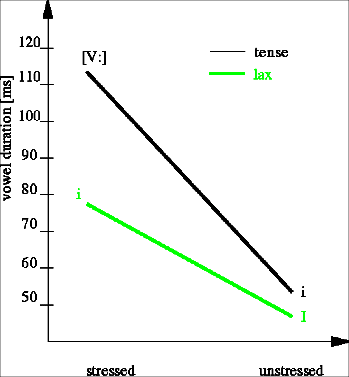
In German, the differences between vowels (as the main elements carrying the stressed/unstressed distinction) inside and outside of a stressed syllable can be influenced (biased) by the tense/lax vowel contrast, so that the search for word stress correlates should take tenseness into account.
Generally, tense vowels are described as having (Trask,1996:352):
* higher muscular tension,
* more extreme movements of the articulators,
* longer duration and
* greater subglottal air pressure
than their counterparts - the lax vowels.
Trask (1996:352) and others criticize this distinction due to its insufficient definition and the weak experimental evidence for it. However, other authors often use the tense/lax terminology. In recent publications, tense/lax activity is interpreted in terms of glottal and supraglottal activity.
With regard to supraglottal activity, the tense/lax vowels in some languages are labelled using the advanced tongue root feature ([+ATR]/[-ATR])[2]. In Germanic languages the vowels differ in the position of the root of the tongue, creating an expanded pharyngeal cavity. They also differ in tongue height (Ladefoged & Maddison, 1996:302-307).
For German, Fischer-Jøergensen (1990) presents articulatory descriptions of tense/lax vowels. In general, lax vowels are shorter, have higher first formant (F1) frequencies and a more centralized F2[3] then tense vowels. The results of Jessen et al. (1995) indicate that the acoustic correlates of the tense/lax vowel distinction in German depend on word stress. Jessen (1993) found that the distinction between tense and lax vowels fully manifests itself under main stress, whereas on lower stress levels the difference between tense and lax vowels is reduced. The unstressed position imposes a strong constraint on the expression of the tense/lax difference. Under main stress the German tense vowels are longer and exhibit a more peripheral articulatory configuration than the lax vowels. In unstressed positions the duration differences are almost entirely neutralized, while the quality differences are more stable (Jessen, 1993).


The tense/lax distinction correlates with laryngeal activity and concerns different voice qualities. Tense voice involves an increase in muscular tension and thus results in a constriction of the larynx and pharynx, heightened subglottal pressure and raised pitch and volume (compare section 5.1). There is evidence for laryngeal correlates of tense/lax elements on the segmental level. Stiff (tense) voice is used in contrast to slack (lax) voice in some languages of China (Maddieson & Ladefoeged, 1985), but also some speakers of American English use laryngeal settings to distinguish tense from lax vowels (Di Paolo & Faber, 1990).
The laryngeal behavior of stressed/unstressed and tense/lax vowels in German was recently investigated by Claßen et al. (1996). Voice production was examined indirectly by means of the acoustical parameters proposed by Stevens and Hanson (1995). The measured parameters are summarized in Table 8. The results of the EGG parametrization are compared with the results of the acoustic measurements in section 17.6.
Table 8: A3* - corrected amplitudes of the second and third formant, respectively. All amplitudes are given
in dB.
| Parameter | Acoustic correlates |
| Open Quotient | H1*-H2* |
| Completeness of closure, glottal leakage | B1 |
| skewness of the glottal pulse (Speed Quotient)
duration of closing portion |
H1* -A2*
H1* - A3* |
| amplitude of voicing | H1* |
Claßen et al. (1996) found that several of these acoustic voice quality parameters depend on stress. More importantly, for unstressed vowels higher values for H1*-A2* and H1*-A3* were found than for stressed vowels.
The experiments by Jessen et al. (1995) and Claßen et al. (1996) provide a basis for a direct comparison with the electroglottography experiment as it was conducted using the same data (a description of the material used in the investigation is given in section 16.1).
2. some authors use the feature expanded pharynx vs. constricted pharynx (Lindau,1978)
3. are centralized on the F1-F2 plane, which means that F2 is lower for front vowels and higher for back vowels